
应用化学 ›› 2023, Vol. 40 ›› Issue (2): 210-228.DOI: 10.19894/j.issn.1000-0518.220151
钾离子电池用Sb基负极材料研究进展
石雪建1,2, 刘万强2, 王春丽1( ), 程勇1, 王立民1
), 程勇1, 王立民1
- 1.中国科学院长春应用化学研究所,稀土资源利用国家重点实验室,长春 130022
2.长春理工大学材料科学与工程学院,长春 130012
-
收稿日期:2022-04-23接受日期:2022-08-08出版日期:2023-02-01发布日期:2023-02-27 -
通讯作者:王春丽 -
基金资助:国家重点研发计划项目(2017YFE0198100);国家自然科学基金(21975250);吉林省科技厅发展项目(20200401031GX);环境友好材料制备与应用教育部重点实验室(吉林师范大学)开放项目(2020005);亚稳态材料科学与技术国家重点实验室(燕山大学)开放项目(202110)
Research Progress of Sb-based Anode Materials for Potassium Ion Batteries
Xue-Jian SHI1,2, Wan-Qiang LIU2, Chun-Li WANG1( ), Yong CHENG1, Li-Min WANG1
), Yong CHENG1, Li-Min WANG1
- 1. State Key Laboratory of Rare Earth Resource Utilization,Changchun Institute of Applied Chemistry,CAS,Changchun 130022,China
2.School of Materials Science and Engineering,Changchun University of Science and Technology,Changchun 130012,China
-
Received:2022-04-23Accepted:2022-08-08Published:2023-02-01Online:2023-02-27 -
Contact:Chun-Li WANG -
About author:clwang@ciac.ac.cn
-
Supported by:the National Key R&D Program of China(2017YFE0198100);the National Natural Science Foundation of China(21975250);the Scientific and Technological Developing Project of Jilin Province(20200401031GX);the Open Project Program of Key Laboratory of Preparation and Application of Environmental Friendly Materials (Jilin Normal University), the Ministry of Education, China(2020005);the Open Program of State Key Laboratory of Metastable Materials Science and Technology (Yanshan University), China(202110)
摘要:
Sb基材料因具有理论容量高、储量丰富、来源广泛、环境友好和安全性高等优势已成为颇具前景的钾离子电池负极材料。但Sb基材料普遍面临结构稳定性较差、动力学迟缓、导电性差等棘手问题,在进行钾离子脱嵌时,材料结构变化大,粉化严重,造成容量衰减过快,仅能获得较差的循环稳定性。此外,固体电解质界面膜(SEI膜)的稳定性也极大地影响着Sb基材料的循环性能。这些问题严重阻碍了Sb基材料发展的脚步。本文归纳了各类Sb基材料的研究进展,重点介绍了通过调控材料结构以及调节电解液体系对电化学性能的影响,对高性能钾离子电池Sb基负极材料的设计做出了展望。
中图分类号:
引用本文
石雪建, 刘万强, 王春丽, 程勇, 王立民. 钾离子电池用Sb基负极材料研究进展[J]. 应用化学, 2023, 40(2): 210-228.
Xue-Jian SHI, Wan-Qiang LIU, Chun-Li WANG, Yong CHENG, Li-Min WANG. Research Progress of Sb-based Anode Materials for Potassium Ion Batteries[J]. Chinese Journal of Applied Chemistry, 2023, 40(2): 210-228.
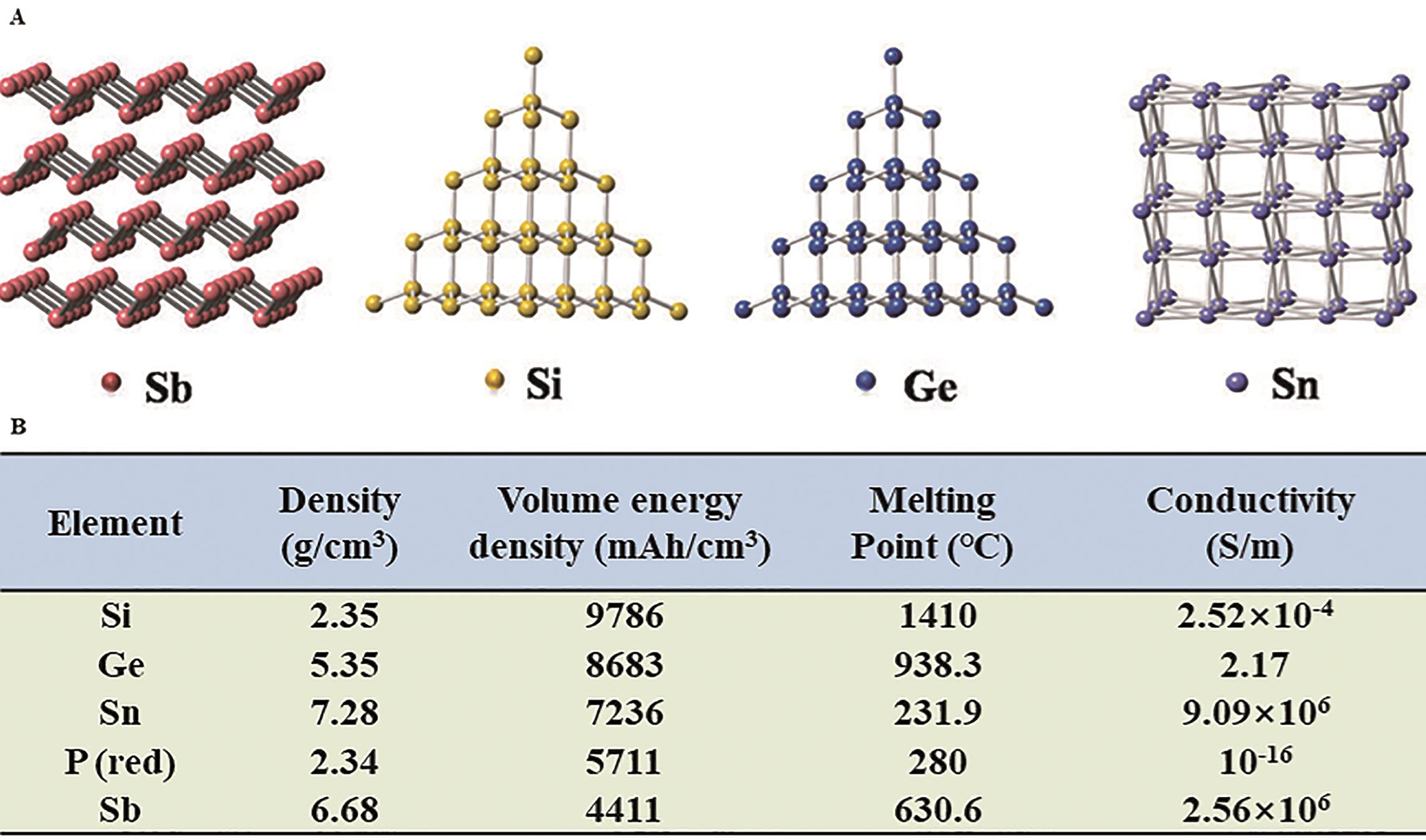
图1 (A)Sb、Si、Ge和Sn的晶体结构示意图; (B)主要合金型电极材料的电化学参数[9]
Fig.1 (A) Schematic diagram of Sb, Si, Ge and Sn crystal structures; (B) Electrochemical parameters of the main alloy-type electrode materials[9]
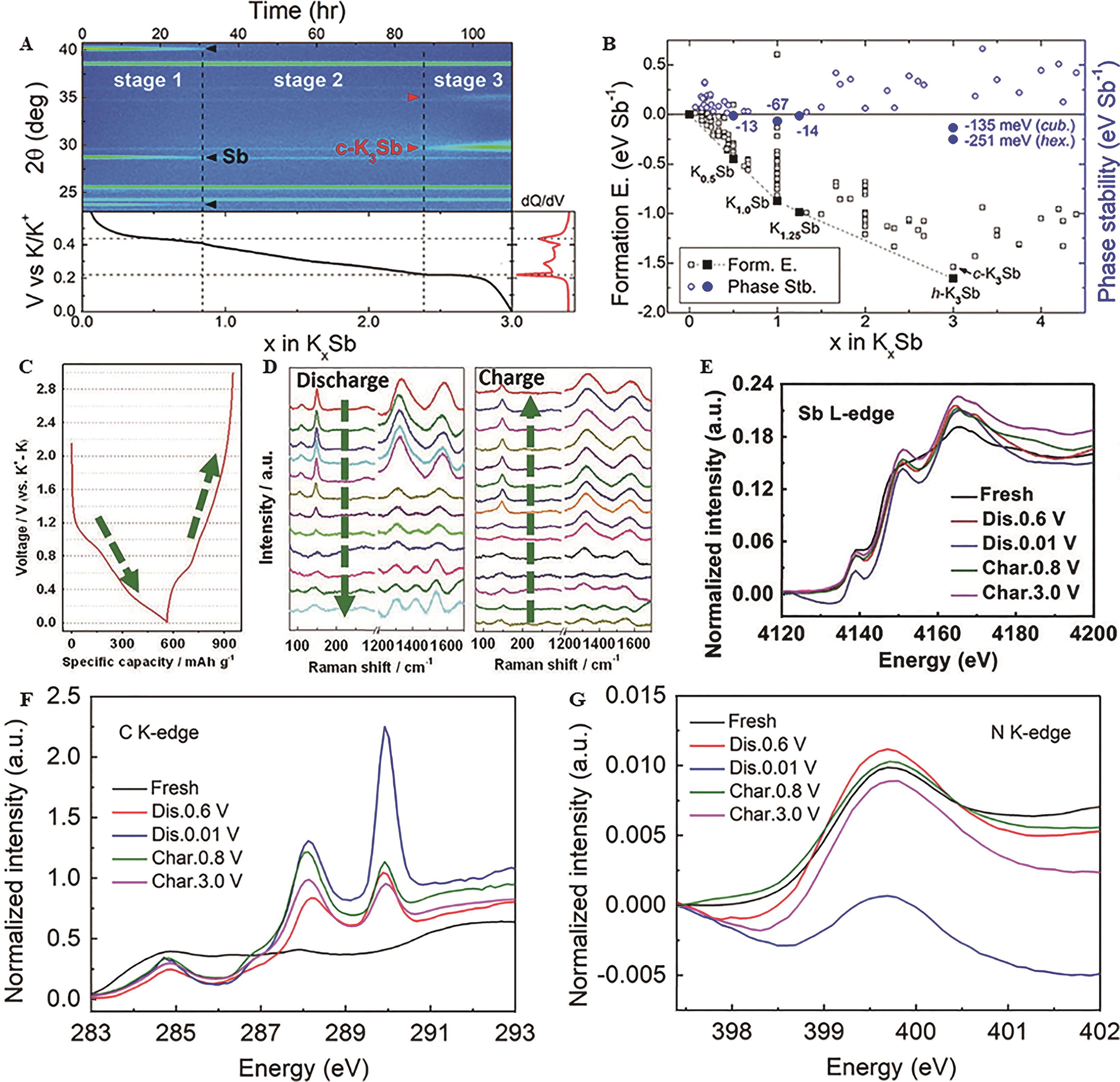
图2 (A) Sb电极首次放电时的原位XRD等高线图; (B)离子取代法得到的K x Sb的生成能[10](0<x≤4.4); 相稳定性是各相相对于其它材料的相对能量; Sb@C PNFs电极的储K+行为: (C) 0.1 A/g时的放电电荷曲线及(D)相应的原位拉曼光谱[11]; u-Sb@CNFs中(E) Sb L-edge、(F) C K-edge、(G) N K-edge的Ex-situ X射线吸收近边结构(XANES)光谱[12]
Fig.2 (A) In-situ XRD measurement of an Sb electrode for the first discharge; (B) Formation energies of K x Sb(0<x≤4.4) obtained by the ionic substitution method[10]; Phase stability is a relative energy of a given phase compared to that of all other materials with different compositions; K+ storage behavior of the as-prepared Sb@C PNFs integrated electrode: (C) Charge and discharge curves at 0.1 A/g, (D) The corresponding in-situ Raman spectra[11]; Ex-situ X-ray absorption near edge structure (XANES) spectra of (E) Sb L-edge, (F)C K-edge and (G) N K-edge of u-Sb@CNFs[12]
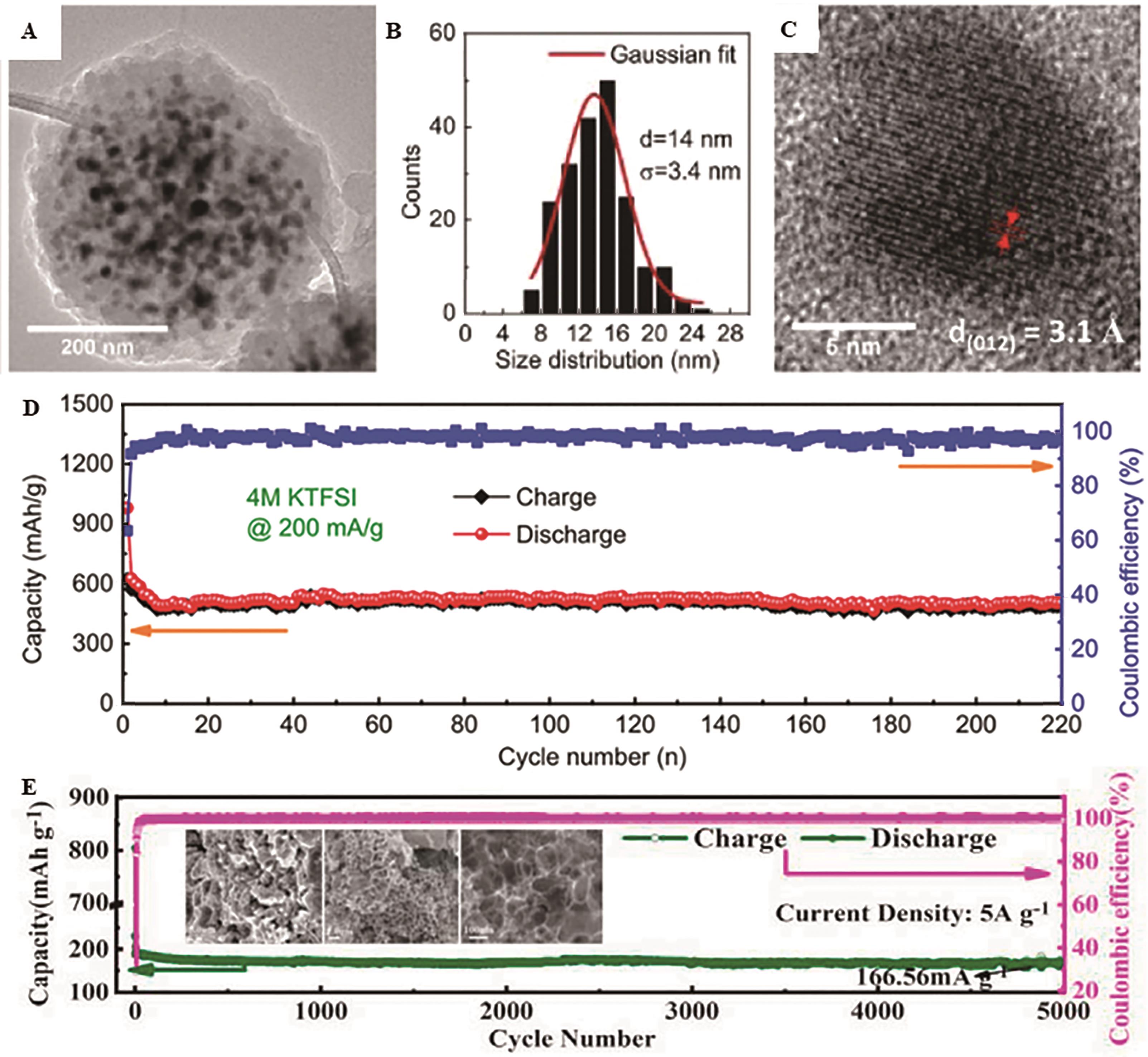
图3 (A) Sb@CSN的 TEM像; (B)为(A)中相应的Sb纳米粒子的尺寸分布曲线; (C) Sb@CSN的HRTEM像; (D) Sb@CSN 负极在4 mol/L KTFSI/EC+DEC电解液体系下,在0.2 A/g电流密度下的循环性能[37]; (E) Se@Sb@C 电极在5 A/g电流密度下的循环性能,内部为3D Se@Sb@C循环5000次的SEM像[38]
Fig.3 (A) TEM image of an individual Sb@CSN sphere and (B) corresponding size distribution curve of Sb nanoparticles from image (A); (C) HRTEM image of Sb@CSN; (D) The cycling performance at 0.2 A/g in the 4 mol/L KTFSI electrolyte for Sb@CSN anode[37]; (E) Cycling stability at 5 A/g of the 3D Se@Sb@C electrode, the insets are SEM images of the 3D Se@Sb@C after 5000 cycles[38]
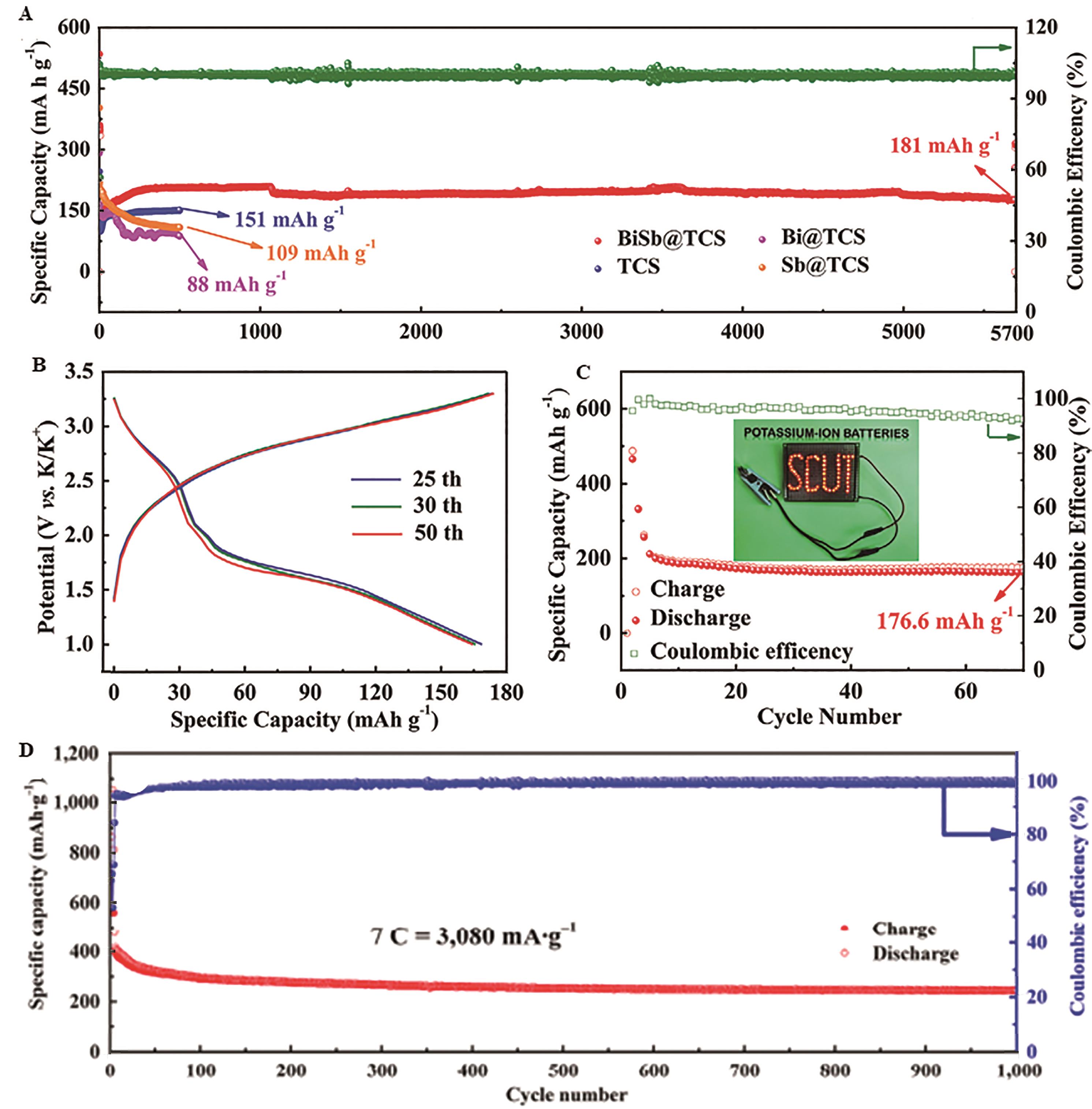
图4 (A) BiSb@TCS 和对照电极在2 A/g电流密度下的长循环性能; BiSb@TCS//普鲁士白全电池的电化学性能; (B)在0.2 A/g电流密度下的充放电曲线; (C)在电流密度下的循环性能, (C)中的插图是全电池点亮LED灯泡的图片[52]; (D) FeSb@C/N?3DC/N 电极在7 C(0.308 A/g)电流密度下的长循环性能[53]
Fig.4 (A) Long-term cycling performances at 2 A/g for BiSb@TCS and control samples; Electrochemical performance of BiSb@TCS//Prussian white analogues full cells; (B) Galvanostatic charge/discharge profiles at 0.2 A/g; (C) Cycling performance at 0.2 A/g; The inset in (C) is photograph of lightening bulbs driven by the full cell[52]; (D) Long-term cycle performance of the FeSb@C/N?3DC/N electrode at a high rate of 7 C[53](0.308 A/g)
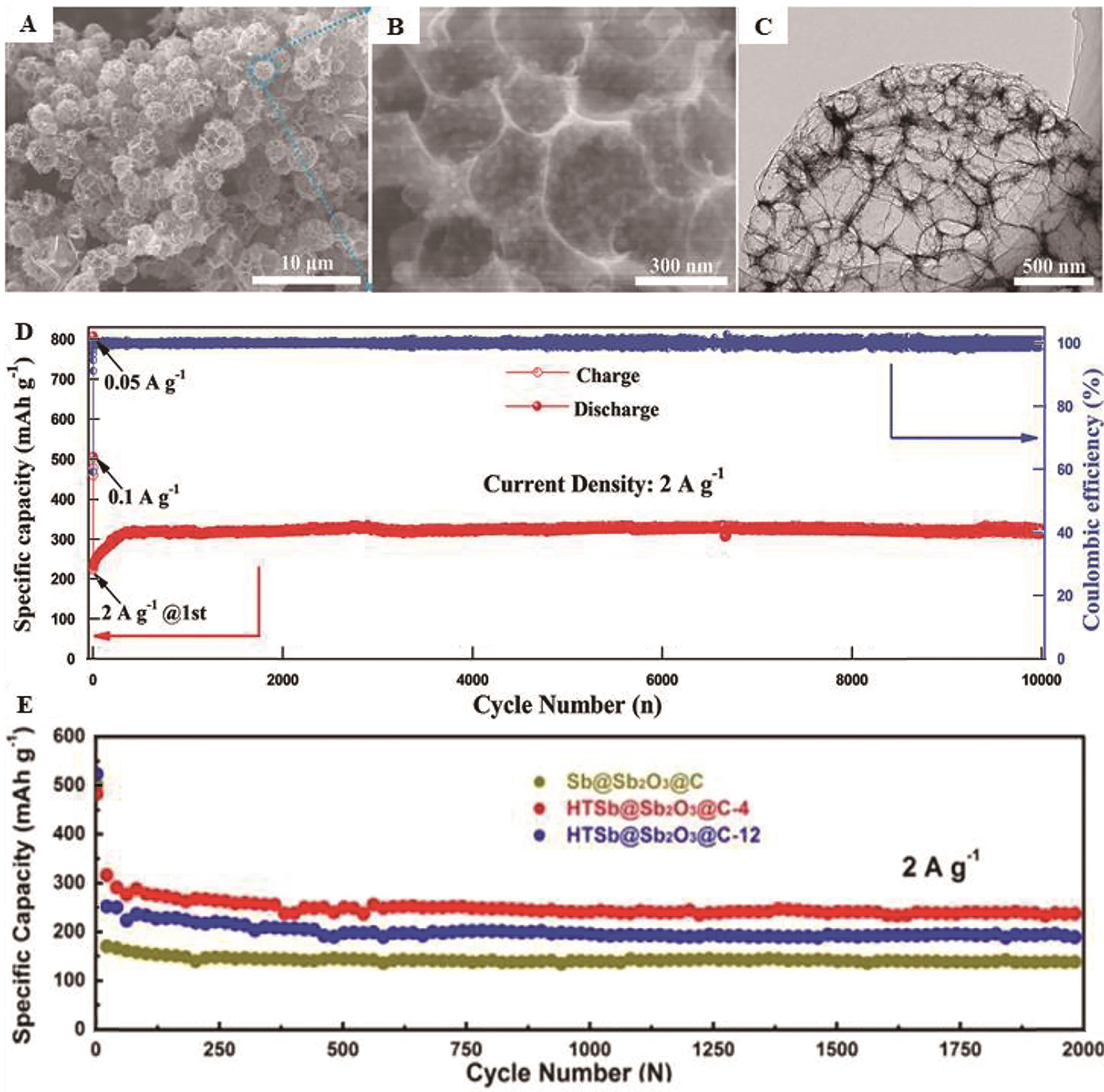
图5 (A)和(B)Sb@Sb2O3@N-3DCHs的SEM像、(C) STEM像; (D) Sb@Sb2O3@N-3DCHs电极在2 A/g电流密度下的长循环性能[58]; (E) HTSb@Sb2O3@C-4电极在0.1 A/g电流密度下的循环性能[57]
Fig.5 (A) and (B) HRTEM image, (C) TEM image Sb@Sb2O3@N-3DCHs; (D) Long-term cycling performance of Sb@Sb2O3@N-3DCHs at a current density of 2 A/g[58]; (E) Cycling performance at 0.1 A/g of HTSb@Sb2O3@C-4[57]
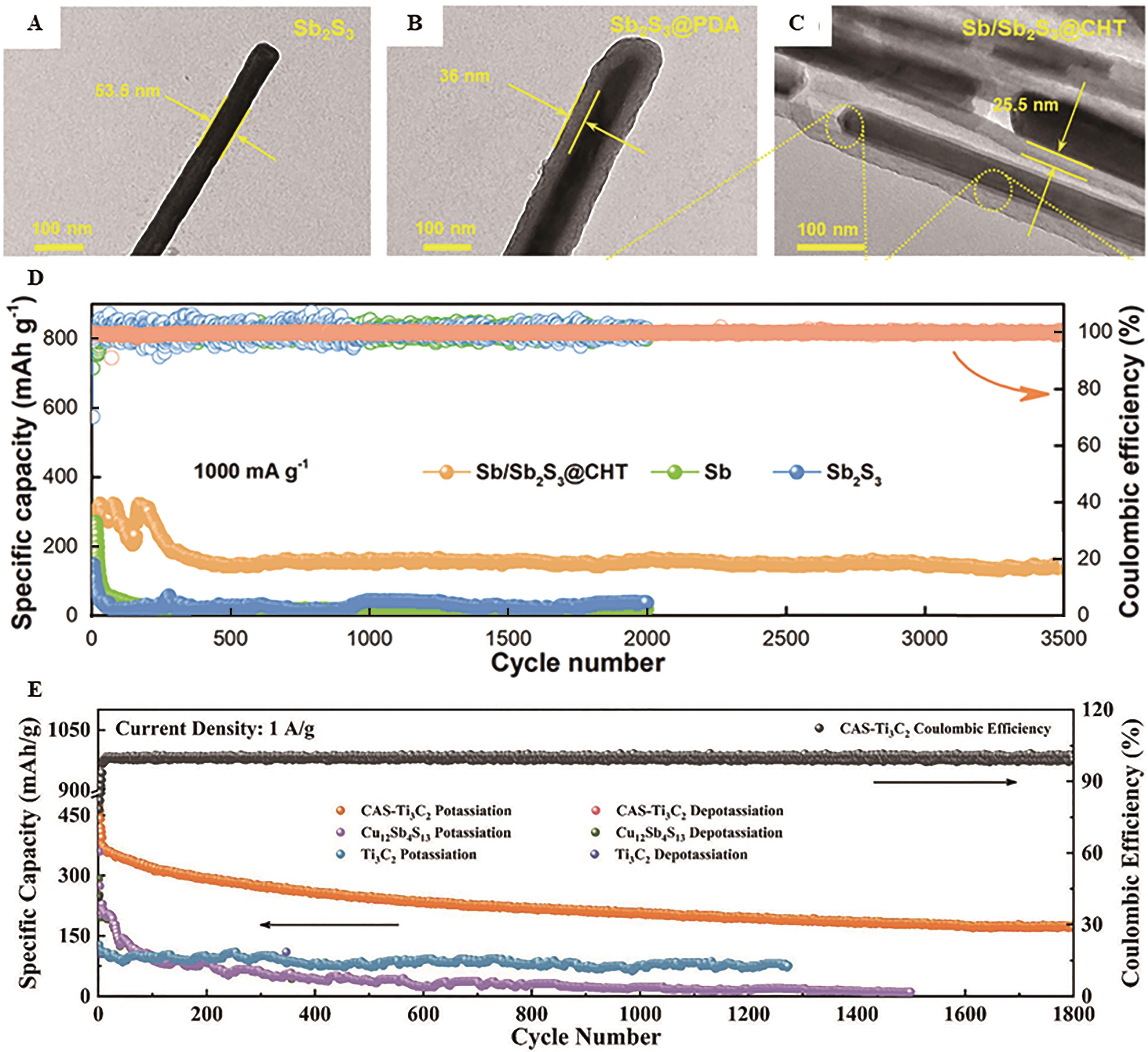
图6 (A) Sb2S3纳米棒、 (B) Sb2S3@PDA、 (C) Sb/Sb2S3@CHT 的TEM像; (D) Sb/Sb2S3@CHT材料在1 A/g电流密度下的长循环性能[64]; (E) CAS-Ti3C2复合材料、 Cu12Sb4S13量子点、 Ti3C2纳米片的长循环性能对比[65]
Fig.6 TEM images of (A) Sb2S3 nanorods, (B) Sb2S3@PDA and (C) Sb/Sb2S3@CHT, respectively; (D) Long cycle performance of commercial Sb powders, as-prepared Sb2S3 nanorods and Sb/Sb2S3@CHT at 1 A/g[64]; (E) Long cyclic performance of CAS-Ti3C2 composites, Cu12Sb4S13 quantum dots and Ti3C2 nanosheets[65]
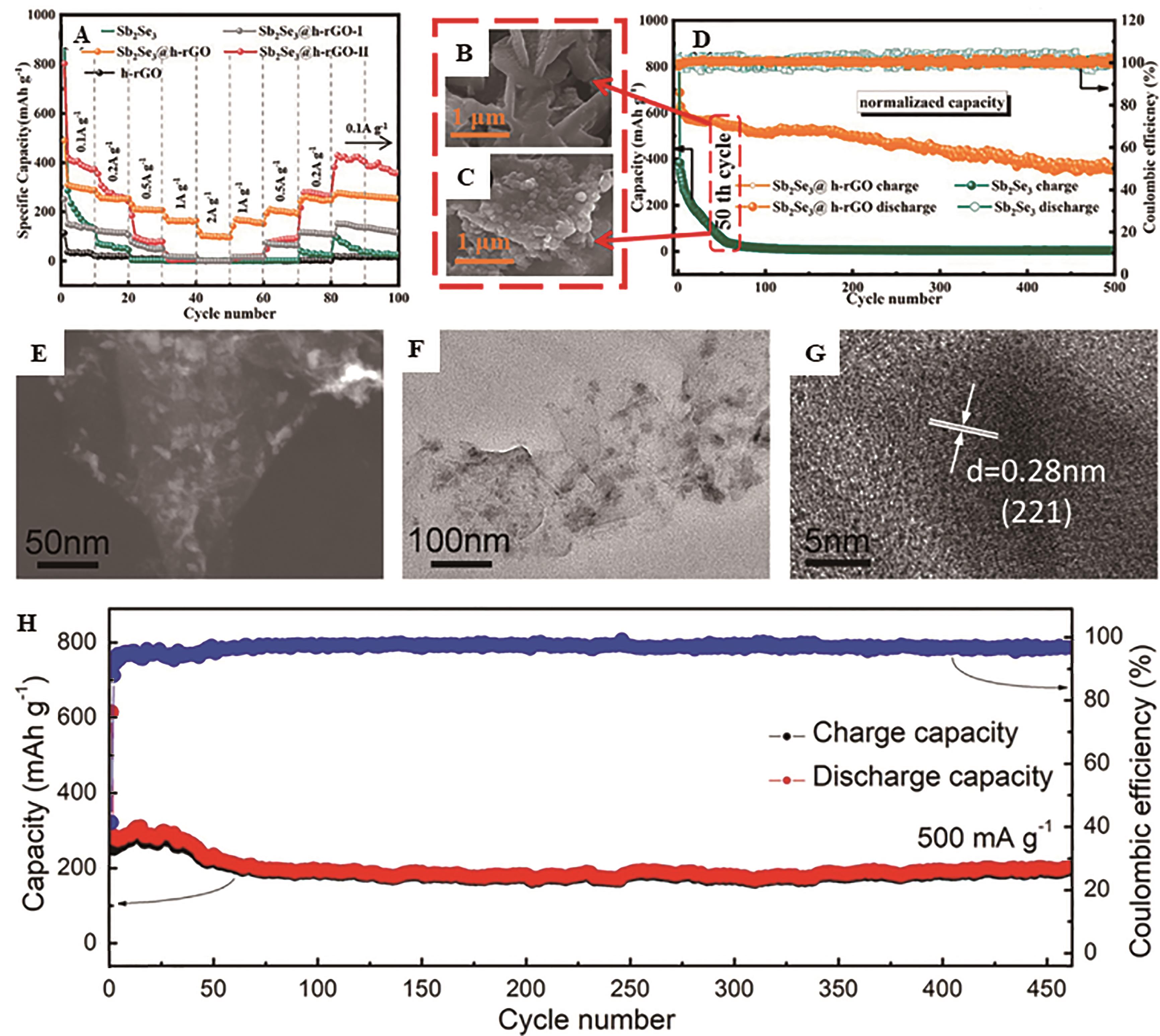
图7 (A) h-rGO、Sb2Se3、Sb2Se3@h-rGO一体化电极、Sb2Se3@h-rGO-I和Sb2Se3@h-rGO-II电极在0.05~2 A/g电流密度下的倍率性能; (B) Sb2Se3@h-rGO一体化电极和(C) Sb2Se3电极50次循环后的SEM像[66]; (D) Sb2Se3@RGO一体化电极和Sb2Se3在0.1 A/g电流密度下的循环性能; Sb2Se3@RGO复合材料 (E) STEM像、(F) TEM像、 (G) HRTEM像; Sb2Se3@RGO复合材料在0.5 A/g 电流密度下的循环性能[67]
Fig.7 (A) Rate capability at the current densities from 0.05 to 2 A/g for h-rGO powder electrode, Sb2Se3 powder electrode, free-standing Sb2Se3@h-rGO, Sb2Se3@h-rGO-I and Sb2Se3@h-rGO-II electrodes; SEM images of (B) free-standing Sb2Se3@h-rGO electrode and (C) Sb2Se3 powder electrode after 50 repeated cycles[66]; (D) Cycling performances of free-standing Sb2Se3@h-rGO electrode and Sb2Se3 powder electrode at 0.1 A/g; (E) STEM images, (F) TEM image and (G) HRTEM image of the self-wrinkled Sb2Se3@RGO composites; The galvanostatic cycling performance of the self-wrinkled Sb2Se3@RGO composites at 0.5 A/g[67]
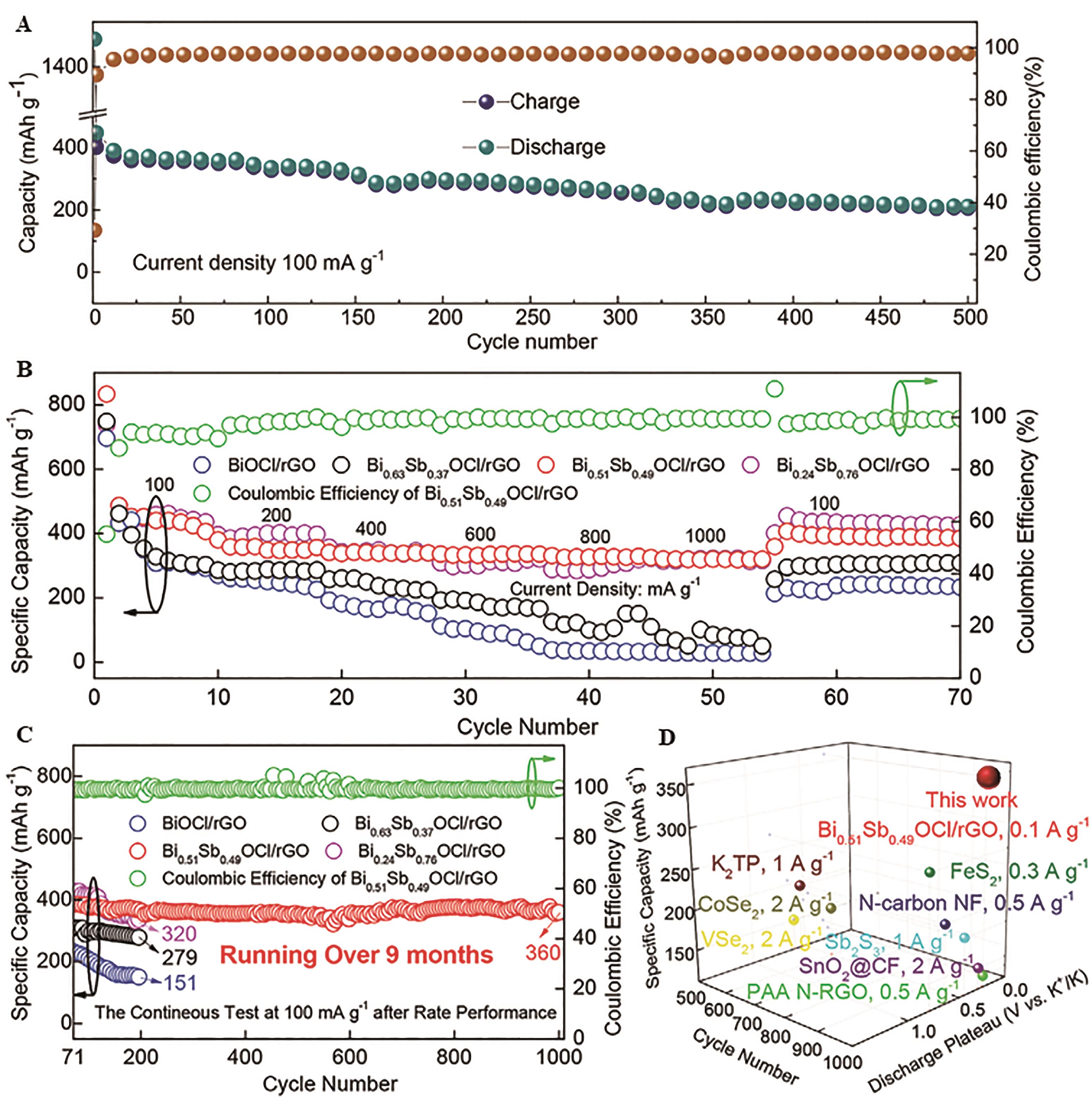
图8 (A) SbVO4@RGO 在0.1 A/g电流密度下的长循环性能[70]; (B) BiOCl/rGO、Bi0.63Sb0.37OCl/ rGO、Bi0.51Sb0.49OCl/rGO和Bi0.24Sb0.76OCl/rGO的倍率性能; (C) BiOCl/rGO、Bi0.63Sb0.37OCl/rGO、Bi0.51Sb0.49OCl/rGO和Bi0.24Sb0.76OCl/rGO在 0.1 A/g电流密度下的循环性能; (D) Bi0.51Sb0.49OCl/rGO和其它电极电极材料的循环性能(至少500次循环)、放电平台和容量的对比[68]
Fig.8 (A) Long-term cycling performance at a current density of 0.1 A/g of SbVO4@RGO[70]; (B) Rate performance of BiOCl/rGO, Bi0.63Sb0.37OCl/rGO, Bi0.51Sb0.49OCl/rGO and Bi0.24Sb0.76OCl/rGO; (C) The continuous test at 0.1 A/g after rate performance of BiOCl/rGO, Bi0.63Sb0.37OCl/rGO, Bi0.51Sb0.49OCl/rGO and Bi0.24Sb0.76OCl/rGO; (D) Comparison of the cycling performance, discharge plateau and specific capacity, between the Bi0.51Sb0.49OCl/rGO and other reported electrodes for PIBs with at least 500 cycles[68]
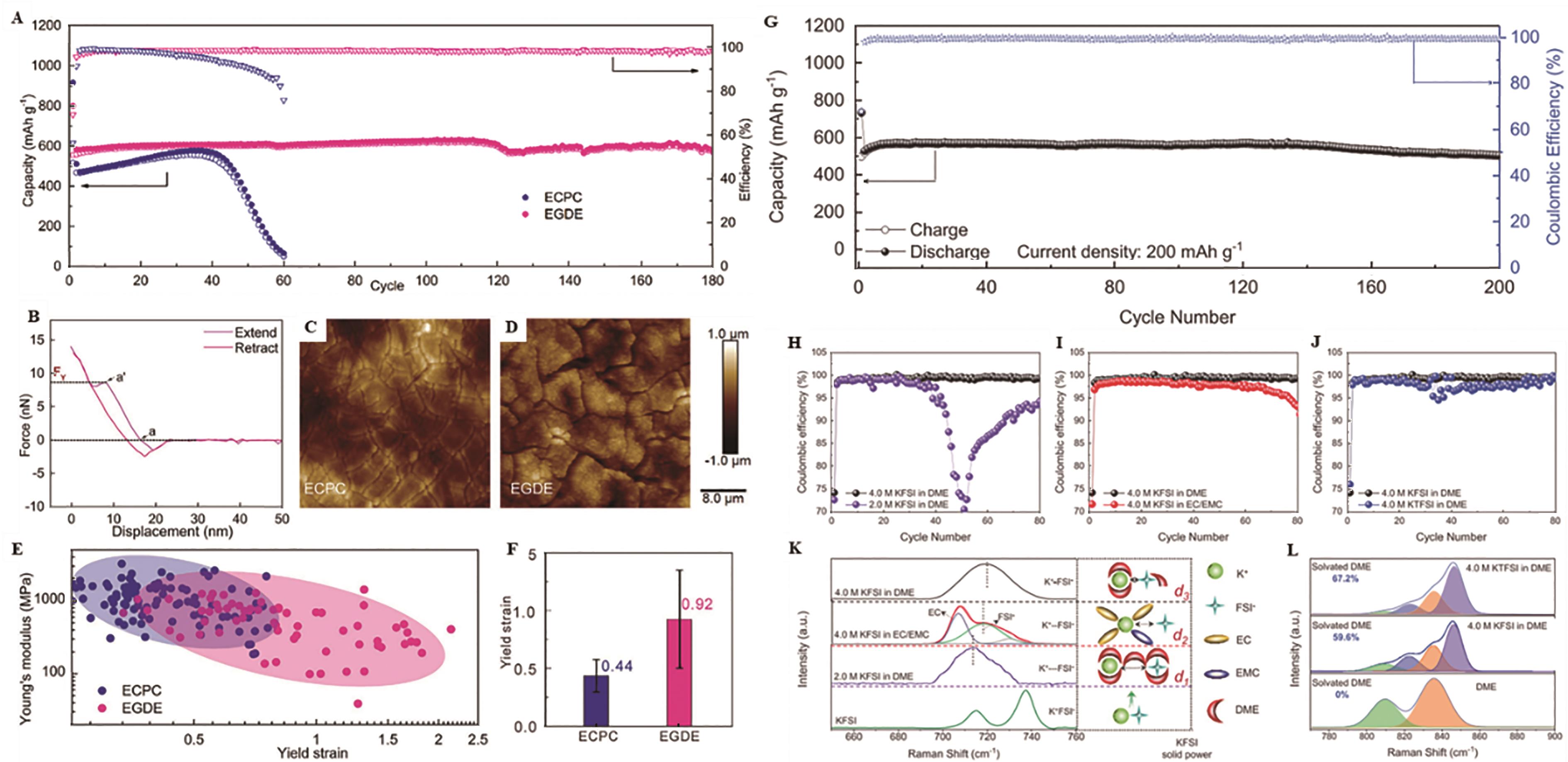
图9 (A) Sb电极分别在1 mol/L KFSI/ECPC 和1 mol/L KFSI/EGDE 电解液体系,在0.1 A/g电流密度下的循环性能; (B) 沉积Sb电极的AFM测试得到的特征力曲线; (C) 1 mol/L KFSI/ECPC和(D) 1 mol/L KFSI/EGDE的AFM像; (E) SEI膜的杨氏模量和屈服应变分布; (F) 屈服应变误差柱状图[73]; (G) Sb电极在0.2 A/g电流密度下的循环性能; (H-J)Sb电极在不同电解液下的首次库伦效率的对比; (K)不同KFSI浓度和溶剂阴离子下FSI-的拉曼光谱,以及相应的离子(即K+、FSI-)与溶剂的相互作用示意图; (L) DME基电解液中DME溶剂在不同钾盐(即KFSI,KTFSI)中的CH2/C—O价键拉伸振动[74]
Fig.9 (A) Cyclic performance under 0.1 A/g in 1 mol/L KFSI/ECPC and 1 mol/L KFSI/EGDE electrolytes of Sb electrode; (B) Characteristic force curves obtained from the AFM tests on electrodeposited Sb electrodes; AFM topography images in (C) 1 mol/L KFSI/ECPC and (D) 1 mol/L KFSI/EGDE; (E) Distributions of Young′s modulus and yield strain of SEIs; (F) Histogram with an error bar of yield strain[73]; (G) Cycling performance of Sb anode at the current density of 0.2 A/g; (H-J) Comparison of Coulombic efficiency of Sb electrode in different electrolytes; (K) Raman spectra of FSI- anions using different KFSI concentrations or different solvents and the corresponding schematic interaction of the ions(i.e. K+, FSI-)and solvent; (L) Comparative Raman spectra showing the CH2 rocking/C—O stretching vibrations of DME solvent in different potassium salts (i.e. KFSI,KTFSI) was used in the DME-based electrolyte[74]
| Classify | Electrode material | Synthetic method | Electrolyte(concentration|solute salt|solvent) | Rate performance(current density|capacity) | Cycling performance (current density|cycle number|capacity) | Initial coulombic efficiency (ICE)/% | Ref. |
|---|---|---|---|---|---|---|---|
| Sb-based materials | Sb@RGO | Solvothermal+thermal reduction | 0.8 mol/L KPF6 in EC|PC | 0.1 A/g|381 mA·h/g | 0.5 A/g|200|210 mA·h/g | - | [ |
| Sb@CNFs | Ion-exchange+thermal reduction | 2 mol/L KFSI|DME | 2 A/g|121 mA·h/g | 1 A/g|1000|227 mA·h/g | 47 | [ | |
| Sb@C PNFs | Electrospinning+ thermal reduction | 1 mol/L KFSI in EC|DEC | 5 A/g|208.1 mA·h/g | 2 A/g|500|264 mA·h/g | 71.3 | [ | |
| u-Sb@CNFs | Electrospinning+ thermal reduction | 3 mol/L KFSI in DME | 5 A/g|145 mA·h/g | 1 A/g|2000|225 mA·h/g | 48.3 | [ | |
| Sb@NPMC | Electrospinning+ thermal reduction | 0.8 mol/L KPF6 in EC|DEC | 1 A/g|161 mA·h/g | 1 A/g|1500|130 mA·h/g | 50 | [ | |
| Sb/CNF-0.5 | Electrospinning | 1 mol/L KFSI in EC|DEC | - | 0.5 A/g|500|403 mA·h/g | 64.7 | [ | |
| Sb/hard carbon | Pyrolysis+ball-milling | 0.8 mol/L KPF6 in EC|DEC | - | 0.1 A/g|50|285 mA·h/g | 44 | [ | |
| Sb/CNS | Solvothermal | 1 mol/L KPF6 in EC|DMC | 2 A/g|101.4 mA·h/g | 0.2 A/g|600|247 mA·h/g | 48 | [ | |
| Sb@HCT | Calcination and reduction | 1 mol/L KTFSI in EC|DMC | 0.5 A/g|453.4 mA·h/g | 2 A/g|120|300.1 mA·h/g | - | [ | |
| Sb/DWCNT | - | 0.8 mol/L KFSI in EC|DEC | 0.88 A/g|453 mA·h/g | 0.11 A/g|30|491 mA·h/g | 88.4 | [ | |
| Sb-P-C | Ball-milling | 0.75 mol/L KPF6 in EC|DEC | - | 0.05 A/g|50|402 mAh/g | - | [ | |
| Sb@G@C | Freeze-dried | 3 mol/L KFSI in DME | 2 A/g|127 mA·h/g | 1 A/g|800|160 mA·h/g | 75.8 | [ | |
| Sb-G-C | Electrospinning | 0.8 mol/L KPF6 in EC|DEC | 1 A/g|120.83 mA·h/g | 0.1 A/g|100|204.95 mA·h/g | 46.84 | [ | |
| Sb/C/RGO | Freeze-dried | 1 mol/L KFSI|DME | 2 A/g|370 mA·h/g | 0.5 A/g|350|400 mA·h/g | 68 | [ | |
| Sb7@G3 | Ball-milling + ultrasonic+ | - | 1 A/g|340 mA·h/g | 0.2 A/g|100|292 mA·h/g | - | [ | |
| Sb/RGO | Freeze-dried | 0.8 mol/L KPF6 in EC|DMC | 1 A/g|180 mA·h/g | 1 A/g|100|140.4 mA·h/g | 60.3 | [ | |
| Sb/rGO | Freeze-dried+thermal reduction | 1 mol/L KPF6 in EC|PC | - | - | 61 | [ | |
| Sb@C-3DP | Ball-milling+thermal reduction | 5 mol/L KFSI in DME | 1 A/g|286 mA·h/g | 0.5 A/g|260|342 mA·h/g | 76.2 | [ | |
| 3D SbNPs@C | Template+freeze-dried +carbothermic reduction | 0.8 mol/L KPF6 in EC|DEC | 1 A/g|288 mA·h/g | 1 A/g|50|225 mA·h/g | 70 | [ | |
| Sb@PC | Liquid-solid absorption | 1 mol/L KPF6 in EC|DEC | 2 A/g|70 mA·h/g | 0.5 A/g|200|90 mA·h/g | 46.2 | [ | |
| Sb/C | - | 0.8 mol/L KFSI in EC|DEC | - | 0.044 A/g|30|365 mA·h/g | 68 | [ | |
| Sb@MCMB-3 | Ball-milling | 3 mol/L KFSI|DME | 5 A/g|293.9 mA·h/g | 1 A/g|500|300.1 mA·h/g | 54.8 | [ | |
| Sb-Co | Reduction precipitation | 0.8 mol/L KPF6 in EC|DEC | 6 A/g|377.8 mA·h/g | 0.06 A/g|100|402.7 mA·h/g | 67.9 | [ | |
| Sn-Sb LSM | Ball-milling | 4 mol/L KFSI in EMC | 5 A/g|118 mA·h/g | 0.5 A/g|150|296 mA·h/g | - | [ | |
| MS@C (MoS2/Sb@C) | Thermal reduction | 1 mol/L KFSI|DME | 2 A/g|235.4 mA·h/g | 2 A/g|1000|170.1 mA·h/g | 59.3 | [ | |
| Sb@CSN | Electrospray+thermal reduction | 4 mol/L KTFSI in EC|DEC | 0.1 A/g|566 mA·h/g | 0.2 A/g|220|504 mA·h/g | - | [ | |
| 3D Se@Sb@C | Template+CVD | 0.8 mol/L KFSI in EC|DEC | 10 A/g|107.7 mA·h/g | 5 A/g|5700|166.6 mA·h/g | 67.5 | [ | |
| NP-Sb | Vacuum-distillation | 0.8 mol/L KPF6 in EC|DEC | 0.5 A/g|265 mA·h/g | 0.1 A/g|50|318 mA·h/g | 71 | [ | |
| SbM-based materials | 3D FeSb@NC | Freeze-dried+thermal reduction | 0.8 mol/L KPF6 in EC|DEC | 2 A/g|119.7 mA·h/g | 0.5 A/g|1000|135 mA·h/g | - | [ |
| Cu2Sb@3DPC | Freeze-dried+thermal reduction | 0.8 mol/L KPF6 in EC|DEC | 5 A/g|148 mA·h/g | 0.1 A/g|100|260 mA·h/g | 20.4 | [ | |
| CoSb@3DPCs | Template+freeze-dried+thermal reduction | 0.8 mol/L KPF6 in EC|DEC | 5 A/g|134 mA·h/g | 1 A/g|500|287.5 mA·h/g | - | [ | |
| Bi0.5Sb0.5@P | Solution precipitation | 4 mol/L KFSI in DME | 6.5A/g|258.5 mA·h/g | 1 A/g|550|339.1 mA·h/g | - | [ | |
| BiSb@C | NaCl-template | 3 mol/L KFSI in DME | 2 A/g|246.8 mA·h/g | 0.5 A/g|1000|303.5 mA·h/g | 82 | [ | |
| BiSb@C | Freeze-dried+pyrolysis | 5 mol/L KFSI in DME | 2 A/g|152 mA·h/g | 0.5 A/g|600|320 mA·h/g | 70.2 | [ | |
| SnSb@C | NaCl template+thermal reduction | 0.8 mol/L KPF6 in EC|DEC | 10 A/g|58.3 mA·h/g | 0.1 A/g|100|293 mA·h/g | 56.2 | [ | |
| SnSb | High-energy ball-milling | 0.8 mol/L KFSI in EC|DEC | - | 0.1 A/g|40|282 mA·h/g | - | [ | |
| SnSb@MAC | Polyesterification | 4 mol/L KFSI in DME | 3.75 A/g|91.3 mA·h/g | 0.5 A/g|5000|200 mA·h/g | - | [ | |
| SnSb-G-C | Electrospinning+ carbonized | 0.8 mol/L KPF6 in EC|DEC | 1 A/g|207.27 mA·h/g | 0.1 A/g|100|275.14 mA·h/g | 52.53 | [ | |
| 3D SnSb@NC | NaCl template+ pyrolysis | 0.5 mol/L KPF6 in DME | 2 A/g|116.6 mA·h/g | 0.5 A/g|200|185.8 mA·h/g | - | [ | |
| BiSb@TCS | Spraying+thermal reduction | 3 mol/L KFSI|DME | 6 A/g|119.3 mA·h/g | 2 A/g|5700|181 mA·h/g | 64.8 | [ | |
| FeSb@C/N?3DC/N | Green salt template | 0.8 mol/L KPF6 in EC|DEC | 0.1 A/g|614 mA·h/g | 0.308 A/g|1000|245 mA·h/g | - | [ | |
| Sb x O y -based materials | BiSb@Bi2O3/SbO x @C | Template+pyrogenic decomposition | 0.8 mol/L KPF6 in EC|DEC | 2 A/g|111 mA·h/g | 1 A/g|500|214 mA·h/g | 34 | [ |
| Sb/Sb2O4/Fe3C | Freeze-dried+heat treatment | 1 mol/L KPF6 in DME | 2 A/g|135 mA·h/g | 2 A/g|1244|108 mA·h/g | - | [ | |
| PAA?N-RGO(PAA, H2Sb2O6·nH2O) | One-pot synthesis | 1 mol/L KPF6 in EC/DMC/EMC | 2 A/g|96 mA·h/g | 0.5 A/g|1000|124 mA·h/g | 51 | [ | |
HTSb @Sb2O3@C-4 | NaCl template+ pyrolysis | 0.8 mol/L KPF6 in EC|DMC | 0.1A/g|543.9 mA·h/g | 2 A/g|2000|273 mA·h/g | 21.6 | [ | |
| Sb@Sb2O3@N-3DCHs | Spray drying+heat treatment | 3 mol/L KFSI in DME | 5 A/g|239 mA·h/g | 2 A/g|10000|319 mA·h/g | - | [ | |
| Sb x S y -based materials | Sb2S3@C | Hydrothermal +carbonization | 1 mol/L KFSI in DME | 1 A/g|163 mA·h/g | 0.05 A/g|50|293 mA·h/g | - | [ |
| Sb2S3-SNG | Freeze-dried | 1 mol/L KPF6 in EC|DEC | 1 A/g|340 mA·h/g | 0.05 A/g|100|537 mA·h/g | 69.7 | [ | |
| (Bi,Sb)2S3 | In situ alloying | 3 mol/L KFSI in DME | 1 A/g|300 mA·h/g | 0.5 A/g|1000|353 mA·h/g | 51.9 | [ | |
| Sb2S3-rGO | Heat treatment | 1 mol/L KPF6 in EC|DEC | - | 0.05 A/g|50|110 mAh/g | - | [ | |
| Sb2S3@PPy | Sonication+freeze-dried | 0.8 mol/L KPF6 in EC|DEC | 2 A/g|220 mA·h/g | 1 A/g|50|157 mA·h/g | 63.7 | [ | |
| Sb/Sb2S3@CHT | Hydrothermal+ coating+carbonization | 4 mol/L KFSI in DME | 2 A/g|173.2 mA·h/g | 1 A/g|3500|147.5 mA·h/g | 62.3 | [ | |
| CAS-Ti3C2(Cu12Sb4S13, CAS) | Acoustic degradation +thermal injection | 0.8 mol/L KPF6 in EC|DEC | 5 A/g|163.3 mA·h/g | 1 A/g|1800|175.6 mA·h/g | 57.2 | [ | |
| Sb x Se y -based materials | Sb2Se3@h-rGO | Vacuum filtration+ thermal reduction | 0.8 mol/L KFSI in EC|DMC | 2 A/g|73 mA·h/g | 0.1 A/g|500|382.8 mA·h/g | 66 | [ |
| Sb2Se3@RGO | Hydrothermal+selenization | 0.8 mol/L KPF6 in EC|PC | 0.1 A/g|391.4 mA·h/g | 0.5 A/g|460|203.4 mA·h/g | 49 | [ | |
| Other Sb-based materials | Bi0.51Sb0.49OCl/rGO | Sol-gel+freeze-dried | 3 mol/L KFSI in DME | 1 A/g|319 mA·h/g | 0.1 A/g|1000|360 mA·h/g | 55.9 | [ |
| Sb2MoO6/rGO | Hydrothermal | 3 mol/L KFSI in DME | 0.2 A/g|381 mA·h/g | 0.5 A/g|100|247 mA·h/g | 55.7 | [ | |
| SbVO4@RGO | Solvothermal | 5 mol/L KFSI in EC| DMC | 0.1 A/g|447.9 mA·h/g | 0.1 A/g|500|210.1 mA·h/g | 29.2 | [ | |
| Opitimi cation of electrolyte | Micro-Sized Sb | Chemical reduction | 1 mol/L KFSI in EGDE | 5 A/g |225 mA·h/g | 0.1 A/g|180|573 mA·h/g | 69.4 | [ |
| Micro-Sized Sb | Commercial Sb powder | 4 mol/L KFSI in DME | 3 A/g|305 mA·h/g | 0.2 A/g|200|553 mA·h/g | - | [ |
表1 不同Sb基材料的组成、制备方法、电解液以及储钾性能的对比
Table 1 Comparison of the synthetic methods, electrolytes, and K+ storage performances of the different Sb-based materials
| Classify | Electrode material | Synthetic method | Electrolyte(concentration|solute salt|solvent) | Rate performance(current density|capacity) | Cycling performance (current density|cycle number|capacity) | Initial coulombic efficiency (ICE)/% | Ref. |
|---|---|---|---|---|---|---|---|
| Sb-based materials | Sb@RGO | Solvothermal+thermal reduction | 0.8 mol/L KPF6 in EC|PC | 0.1 A/g|381 mA·h/g | 0.5 A/g|200|210 mA·h/g | - | [ |
| Sb@CNFs | Ion-exchange+thermal reduction | 2 mol/L KFSI|DME | 2 A/g|121 mA·h/g | 1 A/g|1000|227 mA·h/g | 47 | [ | |
| Sb@C PNFs | Electrospinning+ thermal reduction | 1 mol/L KFSI in EC|DEC | 5 A/g|208.1 mA·h/g | 2 A/g|500|264 mA·h/g | 71.3 | [ | |
| u-Sb@CNFs | Electrospinning+ thermal reduction | 3 mol/L KFSI in DME | 5 A/g|145 mA·h/g | 1 A/g|2000|225 mA·h/g | 48.3 | [ | |
| Sb@NPMC | Electrospinning+ thermal reduction | 0.8 mol/L KPF6 in EC|DEC | 1 A/g|161 mA·h/g | 1 A/g|1500|130 mA·h/g | 50 | [ | |
| Sb/CNF-0.5 | Electrospinning | 1 mol/L KFSI in EC|DEC | - | 0.5 A/g|500|403 mA·h/g | 64.7 | [ | |
| Sb/hard carbon | Pyrolysis+ball-milling | 0.8 mol/L KPF6 in EC|DEC | - | 0.1 A/g|50|285 mA·h/g | 44 | [ | |
| Sb/CNS | Solvothermal | 1 mol/L KPF6 in EC|DMC | 2 A/g|101.4 mA·h/g | 0.2 A/g|600|247 mA·h/g | 48 | [ | |
| Sb@HCT | Calcination and reduction | 1 mol/L KTFSI in EC|DMC | 0.5 A/g|453.4 mA·h/g | 2 A/g|120|300.1 mA·h/g | - | [ | |
| Sb/DWCNT | - | 0.8 mol/L KFSI in EC|DEC | 0.88 A/g|453 mA·h/g | 0.11 A/g|30|491 mA·h/g | 88.4 | [ | |
| Sb-P-C | Ball-milling | 0.75 mol/L KPF6 in EC|DEC | - | 0.05 A/g|50|402 mAh/g | - | [ | |
| Sb@G@C | Freeze-dried | 3 mol/L KFSI in DME | 2 A/g|127 mA·h/g | 1 A/g|800|160 mA·h/g | 75.8 | [ | |
| Sb-G-C | Electrospinning | 0.8 mol/L KPF6 in EC|DEC | 1 A/g|120.83 mA·h/g | 0.1 A/g|100|204.95 mA·h/g | 46.84 | [ | |
| Sb/C/RGO | Freeze-dried | 1 mol/L KFSI|DME | 2 A/g|370 mA·h/g | 0.5 A/g|350|400 mA·h/g | 68 | [ | |
| Sb7@G3 | Ball-milling + ultrasonic+ | - | 1 A/g|340 mA·h/g | 0.2 A/g|100|292 mA·h/g | - | [ | |
| Sb/RGO | Freeze-dried | 0.8 mol/L KPF6 in EC|DMC | 1 A/g|180 mA·h/g | 1 A/g|100|140.4 mA·h/g | 60.3 | [ | |
| Sb/rGO | Freeze-dried+thermal reduction | 1 mol/L KPF6 in EC|PC | - | - | 61 | [ | |
| Sb@C-3DP | Ball-milling+thermal reduction | 5 mol/L KFSI in DME | 1 A/g|286 mA·h/g | 0.5 A/g|260|342 mA·h/g | 76.2 | [ | |
| 3D SbNPs@C | Template+freeze-dried +carbothermic reduction | 0.8 mol/L KPF6 in EC|DEC | 1 A/g|288 mA·h/g | 1 A/g|50|225 mA·h/g | 70 | [ | |
| Sb@PC | Liquid-solid absorption | 1 mol/L KPF6 in EC|DEC | 2 A/g|70 mA·h/g | 0.5 A/g|200|90 mA·h/g | 46.2 | [ | |
| Sb/C | - | 0.8 mol/L KFSI in EC|DEC | - | 0.044 A/g|30|365 mA·h/g | 68 | [ | |
| Sb@MCMB-3 | Ball-milling | 3 mol/L KFSI|DME | 5 A/g|293.9 mA·h/g | 1 A/g|500|300.1 mA·h/g | 54.8 | [ | |
| Sb-Co | Reduction precipitation | 0.8 mol/L KPF6 in EC|DEC | 6 A/g|377.8 mA·h/g | 0.06 A/g|100|402.7 mA·h/g | 67.9 | [ | |
| Sn-Sb LSM | Ball-milling | 4 mol/L KFSI in EMC | 5 A/g|118 mA·h/g | 0.5 A/g|150|296 mA·h/g | - | [ | |
| MS@C (MoS2/Sb@C) | Thermal reduction | 1 mol/L KFSI|DME | 2 A/g|235.4 mA·h/g | 2 A/g|1000|170.1 mA·h/g | 59.3 | [ | |
| Sb@CSN | Electrospray+thermal reduction | 4 mol/L KTFSI in EC|DEC | 0.1 A/g|566 mA·h/g | 0.2 A/g|220|504 mA·h/g | - | [ | |
| 3D Se@Sb@C | Template+CVD | 0.8 mol/L KFSI in EC|DEC | 10 A/g|107.7 mA·h/g | 5 A/g|5700|166.6 mA·h/g | 67.5 | [ | |
| NP-Sb | Vacuum-distillation | 0.8 mol/L KPF6 in EC|DEC | 0.5 A/g|265 mA·h/g | 0.1 A/g|50|318 mA·h/g | 71 | [ | |
| SbM-based materials | 3D FeSb@NC | Freeze-dried+thermal reduction | 0.8 mol/L KPF6 in EC|DEC | 2 A/g|119.7 mA·h/g | 0.5 A/g|1000|135 mA·h/g | - | [ |
| Cu2Sb@3DPC | Freeze-dried+thermal reduction | 0.8 mol/L KPF6 in EC|DEC | 5 A/g|148 mA·h/g | 0.1 A/g|100|260 mA·h/g | 20.4 | [ | |
| CoSb@3DPCs | Template+freeze-dried+thermal reduction | 0.8 mol/L KPF6 in EC|DEC | 5 A/g|134 mA·h/g | 1 A/g|500|287.5 mA·h/g | - | [ | |
| Bi0.5Sb0.5@P | Solution precipitation | 4 mol/L KFSI in DME | 6.5A/g|258.5 mA·h/g | 1 A/g|550|339.1 mA·h/g | - | [ | |
| BiSb@C | NaCl-template | 3 mol/L KFSI in DME | 2 A/g|246.8 mA·h/g | 0.5 A/g|1000|303.5 mA·h/g | 82 | [ | |
| BiSb@C | Freeze-dried+pyrolysis | 5 mol/L KFSI in DME | 2 A/g|152 mA·h/g | 0.5 A/g|600|320 mA·h/g | 70.2 | [ | |
| SnSb@C | NaCl template+thermal reduction | 0.8 mol/L KPF6 in EC|DEC | 10 A/g|58.3 mA·h/g | 0.1 A/g|100|293 mA·h/g | 56.2 | [ | |
| SnSb | High-energy ball-milling | 0.8 mol/L KFSI in EC|DEC | - | 0.1 A/g|40|282 mA·h/g | - | [ | |
| SnSb@MAC | Polyesterification | 4 mol/L KFSI in DME | 3.75 A/g|91.3 mA·h/g | 0.5 A/g|5000|200 mA·h/g | - | [ | |
| SnSb-G-C | Electrospinning+ carbonized | 0.8 mol/L KPF6 in EC|DEC | 1 A/g|207.27 mA·h/g | 0.1 A/g|100|275.14 mA·h/g | 52.53 | [ | |
| 3D SnSb@NC | NaCl template+ pyrolysis | 0.5 mol/L KPF6 in DME | 2 A/g|116.6 mA·h/g | 0.5 A/g|200|185.8 mA·h/g | - | [ | |
| BiSb@TCS | Spraying+thermal reduction | 3 mol/L KFSI|DME | 6 A/g|119.3 mA·h/g | 2 A/g|5700|181 mA·h/g | 64.8 | [ | |
| FeSb@C/N?3DC/N | Green salt template | 0.8 mol/L KPF6 in EC|DEC | 0.1 A/g|614 mA·h/g | 0.308 A/g|1000|245 mA·h/g | - | [ | |
| Sb x O y -based materials | BiSb@Bi2O3/SbO x @C | Template+pyrogenic decomposition | 0.8 mol/L KPF6 in EC|DEC | 2 A/g|111 mA·h/g | 1 A/g|500|214 mA·h/g | 34 | [ |
| Sb/Sb2O4/Fe3C | Freeze-dried+heat treatment | 1 mol/L KPF6 in DME | 2 A/g|135 mA·h/g | 2 A/g|1244|108 mA·h/g | - | [ | |
| PAA?N-RGO(PAA, H2Sb2O6·nH2O) | One-pot synthesis | 1 mol/L KPF6 in EC/DMC/EMC | 2 A/g|96 mA·h/g | 0.5 A/g|1000|124 mA·h/g | 51 | [ | |
HTSb @Sb2O3@C-4 | NaCl template+ pyrolysis | 0.8 mol/L KPF6 in EC|DMC | 0.1A/g|543.9 mA·h/g | 2 A/g|2000|273 mA·h/g | 21.6 | [ | |
| Sb@Sb2O3@N-3DCHs | Spray drying+heat treatment | 3 mol/L KFSI in DME | 5 A/g|239 mA·h/g | 2 A/g|10000|319 mA·h/g | - | [ | |
| Sb x S y -based materials | Sb2S3@C | Hydrothermal +carbonization | 1 mol/L KFSI in DME | 1 A/g|163 mA·h/g | 0.05 A/g|50|293 mA·h/g | - | [ |
| Sb2S3-SNG | Freeze-dried | 1 mol/L KPF6 in EC|DEC | 1 A/g|340 mA·h/g | 0.05 A/g|100|537 mA·h/g | 69.7 | [ | |
| (Bi,Sb)2S3 | In situ alloying | 3 mol/L KFSI in DME | 1 A/g|300 mA·h/g | 0.5 A/g|1000|353 mA·h/g | 51.9 | [ | |
| Sb2S3-rGO | Heat treatment | 1 mol/L KPF6 in EC|DEC | - | 0.05 A/g|50|110 mAh/g | - | [ | |
| Sb2S3@PPy | Sonication+freeze-dried | 0.8 mol/L KPF6 in EC|DEC | 2 A/g|220 mA·h/g | 1 A/g|50|157 mA·h/g | 63.7 | [ | |
| Sb/Sb2S3@CHT | Hydrothermal+ coating+carbonization | 4 mol/L KFSI in DME | 2 A/g|173.2 mA·h/g | 1 A/g|3500|147.5 mA·h/g | 62.3 | [ | |
| CAS-Ti3C2(Cu12Sb4S13, CAS) | Acoustic degradation +thermal injection | 0.8 mol/L KPF6 in EC|DEC | 5 A/g|163.3 mA·h/g | 1 A/g|1800|175.6 mA·h/g | 57.2 | [ | |
| Sb x Se y -based materials | Sb2Se3@h-rGO | Vacuum filtration+ thermal reduction | 0.8 mol/L KFSI in EC|DMC | 2 A/g|73 mA·h/g | 0.1 A/g|500|382.8 mA·h/g | 66 | [ |
| Sb2Se3@RGO | Hydrothermal+selenization | 0.8 mol/L KPF6 in EC|PC | 0.1 A/g|391.4 mA·h/g | 0.5 A/g|460|203.4 mA·h/g | 49 | [ | |
| Other Sb-based materials | Bi0.51Sb0.49OCl/rGO | Sol-gel+freeze-dried | 3 mol/L KFSI in DME | 1 A/g|319 mA·h/g | 0.1 A/g|1000|360 mA·h/g | 55.9 | [ |
| Sb2MoO6/rGO | Hydrothermal | 3 mol/L KFSI in DME | 0.2 A/g|381 mA·h/g | 0.5 A/g|100|247 mA·h/g | 55.7 | [ | |
| SbVO4@RGO | Solvothermal | 5 mol/L KFSI in EC| DMC | 0.1 A/g|447.9 mA·h/g | 0.1 A/g|500|210.1 mA·h/g | 29.2 | [ | |
| Opitimi cation of electrolyte | Micro-Sized Sb | Chemical reduction | 1 mol/L KFSI in EGDE | 5 A/g |225 mA·h/g | 0.1 A/g|180|573 mA·h/g | 69.4 | [ |
| Micro-Sized Sb | Commercial Sb powder | 4 mol/L KFSI in DME | 3 A/g|305 mA·h/g | 0.2 A/g|200|553 mA·h/g | - | [ |
| 1 | MASESE T, YOSHII K, YAMAGUCHI Y, et al. Rechargeable potassium-ion batteries with honeycomb-layered tellurates as high voltage cathodes and fast potassium-ion conductors[J]. Nat Commun, 2018, 9: 3823. |
| 2 | WU Y, B HUANG H, FENG Y Z, et al. The promise and challenge of phosphorus-based composites as anode materials for potassium-ion batteries[J]. Adv Mater, 2019, 31(50): 1901414. |
| 3 | LIAO J Y, CHEN C L, HU Q, et al. A low-strain phosphate cathode for high-rate and ultralong cycle-life potassium-ion batteries[J]. Angew Chem Int Ed, 2021, 60(48): 25575-25582. |
| 4 | MIN X, XIAO J, FANG M H, et al. Potassium-ion batteries: outlook on present and future technologies[J]. Energy Environ Sci, 2021, 14(4): 2186-2243. |
| 5 | TANG X, ZHOU D, LI P, et al. MXene-based dendrite-free potassium metal batteries[J]. Adv Mater, 2020, 32(4): 1906739. |
| 6 | 陈跃颖, 盘盈滢, 杜文卿, 等. 金属-有机框架在锂离子电池电极材料中的应用[J]. 材料研究与应用, 2022, 16(1): 68-80. |
| CHEN Y Y, PAN Y Y, DU W Q, et al. Application of metal-organic framework in electrode materials of lithium-ion batteries[J]. Mater Res Appl, 2022, 16(1): 68-80. | |
| 7 | YI Z, LIN N, ZHANG W Q, et al. Preparation of Sb nanoparticles in molten salt and their potassium storage performance and mechanism[J]. Nanoscale, 2018, 10(27): 13236-13241. |
| 8 | HUANG H W, WANG J W, YANG X F, et al. Unveiling the advances of nanostructure design for alloy-type potassium-ion battery anodes via in situ TEM[J]. Angew Chem Int Ed, 2020, 59(34): 14504-14510. |
| 9 | HE J, WEI Y, ZHAI T, et al. Antimony-based materials as promising anodes for rechargeable lithium-ion and sodium-ion batteries[J]. Mater Chem Front, 2018, 2(3): 437-455. |
| 10 | KO Y N, CHOI S H, KIM H, et al. One-pot formation of Sb-carbon microspheres with graphene sheets: potassium-ion storage properties and discharge mechanisms[J]. ACS Appl Mater Interfaces, 2019, 11(31): 27973-27981. |
| 11 | CAO K, LIU H, JIA Y, et al. Flexible antimony@carbon integrated anode for high‐performance potassium-ion battery[J]. Adv Mater Technol, 2020, 5(6): 2000199. |
| 12 | GE X, LIU S, QIAO M, et al. Enabling superior electrochemical properties for highly efficient potassium storage by impregnating ultrafine Sb nanocrystals within nanochannel-containing carbon nanofibers[J]. Angew Chem Int Ed, 2019, 58(41): 14578-14583. |
| 13 | LIU D Y, YANG L, CHEN Z Y, et al. Ultra-stable Sb confined into N-doped carbon fibers anodes for high-performance potassium-ion batteries[J]. Sci Bull, 2020, 65(12): 1003-1012. |
| 14 | ZHANG W M, MIAO W F, LIU X Y, et al. High-rate and ultralong-stable potassium-ion batteries based on antimony-nanoparticles encapsulated in nitrogen and phosphorus co-doped mesoporous carbon nanofibers as an anode material[J]. J Alloys Compd, 2018, 769: 141-148. |
| 15 | LIU H J, WANG Z J, WU Z H, et al. Direct tuning of meso-/micro-porous structure of carbon nanofibers confining Sb nanocrystals for advanced sodium and potassium storage[J]. J Alloys Compd, 2020, 833: 155127. |
| 16 | AHUJA V, SENTHILKUMAR B, SENGUTTUVAN P. Ultra-stable Sb/hard carbon composite anodes with synergistic alkali-ion storage performances[J]. Mater Res Bull, 2021, 144: 111491. |
| 17 | HAN Y, LI T Q, LI Y, et al. Stabilizing antimony nanocrystals within ultrathin carbon nanosheets for high-performance K-ion storage[J]. Energy Storage Mater, 2019, 20: 46-54. |
| 18 | LUO W, LI F, ZHANG W R, et al. Encapsulating segment-like antimony nanorod in hollow carbon tube as long-lifespan, high-rate anodes for rechargeable K-ion batteries[J]. Nano Res, 2019, 12(5): 1025-1031. |
| 19 | GABAUDAN V, TOUJA J, COT D, et al. Double-walled carbon nanotubes, a performing additive to enhance capacity retention of antimony anode in potassium-ion batteries[J]. Electrochem Commun, 2019, 105:106493. |
| 20 | SULTANA I, RAHMAN M M, LIU J N, et al. Antimony-carbon nanocomposites for potassium-ion batteries: insight into the failure mechanism in electrodes and possible avenues to improve cyclic stability[J]. J Power Sources, 2019, 413: 476-484. |
| 21 | LIU Q, FAN L, MA R F, et al. Super long-life potassium-ion batteries based on an antimony@carbon composite anode[J]. Chem Commun, 2018, 54(83): 11773-11776. |
| 22 | HUANG Z, DING S S, LI P C, et al. Flexible Sb-graphene-carbon nanofibers as binder-free anodes for potassium-ion batteries with enhanced properties[J]. Nanotechnol, 2021, 32(2):025401. |
| 23 | YANG X, ZHANG R Y, XU S F, et al. Graphene/amorphous carbon restriction structure for stable and long-lifespan antimony anode in potassium-ion batteries[J]. Chem Eur J, 2020, 26(26): 5818-5823. |
| 24 | LIU Q, FAN L, CHEN S H, et al. Antimony-graphite composites for a high-performance potassium-ion battery[J]. Energy Technol, 2019, 7(10): 1900634. |
| 25 | YANG X, ZHANG R Y. High-capacity graphene-confined antimony nanoparticles as a promising anode material for potassium-ion batteries[J]. J Alloys Compd, 2020, 834: 155191. |
| 26 | WANG L, JIA J J, WU Y, et al. Antimony/reduced graphene oxide composites as advanced anodes for potassium ion batteries[J]. J Appl Electrochem, 2018, 48(10): 1115-1120. |
| 27 | HE X D, LIU Z H, LIAO J Y, et al. A three-dimensional macroporous antimony@carbon composite as a high-performance anode material for potassium-ion batteries[J]. J Mater Chem A, 2019, 7(16): 9629-9637. |
| 28 | HAN C H, HAN K, WANG X P, et al. Three-dimensional carbon network confined antimony nanoparticle anodes for high-capacity K-ion batteries[J]. Nanoscale, 2018, 10(15): 6820-6826. |
| 29 | WANG H, WU X, QI X J, et al. Sb nanoparticles encapsulated in 3D porous carbon as anode material for lithium-ion and potassium-ion batteries[J]. Mater Res Bull, 2018, 103: 32-37. |
| 30 | GABAUDAN V, BERTHELOT R, STIEVANO L, et al. Inside the alloy mechanism of Sb and Bi electrodes for K-ion batteries[J]. J Phys Chem C, 2018, 122(32): 18266-18273. |
| 31 | JI F J, LIU T Q, LI Y Z, et al. Ball-milling strategy for fast and stable potassium-ion storage in antimony-carbon composite anodes[J]. ChemElectroChem, 2020, 7(22): 4587-4593. |
| 32 | ZHANG Y F, LI M, HUANG F B, et al. 3D porous Sb-Co nanocomposites as advanced anodes for sodium-ion batteries and potassium-ion batteries[J]. Appl Surf Sci, 2020, 499:143907. |
| 33 | DING H B, WANG J, FAN L, et al. Sn-Sb compounds with novel structure for stable potassium storage[J]. Chem Eng J, 2020, 395:125417. |
| 34 | ZHAO N, QIN J, CHU L J, et al. Heterogeneous interface of Se@Sb@C boosting potassium storage[J]. Nano Energy, 2020, 78. |
| 35 | CAO L, ZHANG B, XIA H F, et al. Hierarchical chrysanthemum-like MoS2/Sb heterostructure encapsulated into N-doped graphene framework for superior potassium-ion storage[J]. Chem Eng J, 2020, 387:124060. |
| 36 | ZHAO R Z, DI H X, WANG C X, et al. Encapsulating ultrafine Sb nanoparticles in Na+ pre-intercalated 3D porous Ti3C2TX MXene nanostructures for enhanced potassium storage performance[J]. ACS Nano, 2020, 14(10): 13938-13951. |
| 37 | ZHENG J, YANG Y, FAN X, et al. Extremely stable antimony-carbon composite anodes for potassium-ion batteries[J]. Energy Environ Sci, 2019, 12(2): 615-623. |
| 38 | ZHAO N, QIN J, CHU L, et al. Heterogeneous interface of Se@Sb@C boosting potassium storage[J]. Nano Energy, 2020, 78: 105345. |
| 39 | AN Y, TIAN Y, CI L, et al. Micron-sized nanoporous antimony with tunable porosity for high-performance potassium-ion batteries[J]. ACS Nano, 2018, 12(12): 12932-12940. |
| 40 | WANG Z, DONG K, WANG D, et al. Constructing N-doped porous carbon confined FeSb alloy nanocomposite with Fe-N-C coordination as a universal anode for advanced Na/K-ion batteries[J]. Chem Eng J, 2020, 384: 123327. |
| 41 | WANG D, MA Q, TIAN K H, et al. Ultrafine nano-scale Cu2Sb alloy confined in three-dimensional porous carbon as an anode for sodium-ion and potassium-ion batteries[J]. Int J Min Met Mater, 2021, 28(10): 1666-1674. |
| 42 | WANG D, MA Q, TIAN K, et al. Nanosized CoSb alloy confined in honeycomb carbon framework toward high‐property potassium-ion and sodium-ion batteries[J]. Energy Technol, 2021, 9(7): 2100095. |
| 43 | CHEN K T, TUAN H Y. Bi-Sb nanocrystals embedded in phosphorus as high-performance potassium ion battery electrodes[J]. ACS Nano, 2020, 14(9): 11648-11661. |
| 44 | WU Q, CHEN B, XIE H, et al. Bismuth-antimony alloy nanoparticles encapsulated in 3D carbon framework: synergistic effect for enhancing interfacial potassium storage[J]. Chem Eng J, 2022, 430(3): 132906. |
| 45 | XIONG P, WU J, ZHOU M, et al. Bismuth-antimony alloy nanoparticle@porous carbon nanosheet composite anode for high-performance potassium-ion batteries[J]. ACS Nano, 2020, 14(1): 1018-1026. |
| 46 | ZHAO H, ZHUANG C, XU J, et al. Synergistically enhanced sodium/potassium ion storage performance of SnSb alloy particles confined in three-dimensional carbon framework[J]. Ionics, 2020, 26(10): 5019-5028. |
| 47 | GABAUDAN V, BERTHELOT R, SOUGRATI M T, et al. SnSb vs.Sn: improving the performance of Sn-based anodes for K-ion batteries by synergetic alloying with Sb[J]. J Mater Chem A, 2019, 7(25): 15262-15270. |
| 48 | HSIEH Y Y, CHEN K T, TUAN H Y. A synergetic SnSb-amorphous carbon composites prepared from polyesterification process as an ultrastable potassium-ion battery anode[J]. Chem Eng J, 2021, 420(3): 130451. |
| 49 | HUANG Z, CHEN Z, DING S, et al. Multi-protection from nanochannels and graphene of SnSb-graphene carbon composites ensuring high properties for potassium-ion batteries[J]. Solid State Ionics, 2018, 324: 267-275. |
| 50 | SHI X, LIU W, ZHANG D, et al. Nanoscale localized growth of SnSb for general-purpose high performance alkali (Li, Na, K) ion storage[J]. Chem Eng J, 2022, 431(3): 134318. |
| 51 | WANG Z, DONG K, WANG D, et al. A nanosized SnSb alloy confined in N-doped 3D porous carbon coupled with ether-based electrolytes toward high-performance potassium-ion batteries[J]. J Mater Chem A, 2019, 7(23): 14309-14318. |
| 52 | HUANG C, XU A, LI G, et al. Alloyed BiSb nanoparticles confined in tremella-like carbon microspheres for ultralong-life potassium ion batteries[J]. Small, 2021, 17(23): e2100685. |
| 53 | LI Z, GAN Q, ZHANG Y, et al. FeSb@N-doped carbon quantum dots anchored in 3D porous N-doped carbon with pseudocapacitance effect enabling fast and ultrastable potassium storage[J]. Nano Res, 2021, 15(1): 217-224. |
| 54 | WANG Z, DUAN C, WANG D, et al. BiSb@Bi2O3/SbOx encapsulated in porous carbon as anode materials for sodium/potassium-ion batteries with a high pseudocapacitive contribution[J]. J Colloid Sci, 2020, 580: 429-438. |
| 55 | WANG J, CAO M, XU F, et al. A cage compound precursor-derived Sb/Sb2O4/Fe3C nanocomposite anchored on reduced graphene oxide as an anode for potassium ion batteries[J]. New J Chem, 2021, 45(2): 993-1000. |
| 56 | WANG B, DENG Z, XIA Y, et al. Realizing reversible conversion-alloying of Sb(V) in polyantimonic acid for fast and durable lithium- and potassium-ion storage[J]. Adv Energy Mater, 2019, 10(1): 1903119. |
| 57 | MA Q, SONG L, WAN Y, et al. Precise tuning of low-crystalline Sb@Sb2O3 confined in 3D porous carbon network for fast and stable potassium ion storage[J]. J Mater Sci Technol, 2021, 94: 123-129. |
| 58 | CHEN B, YANG L, BAI X, et al. Heterostructure engineering of core-shelled Sb@Sb2O3 encapsulated in 3D N-doped carbon hollow-spheres for superior sodium/potassium storage[J]. Small, 2021, 17(6): e2006824. |
| 59 | CHENG Y, YAO Z, ZHANG Q, et al. In situ atomic-scale observation of reversible potassium storage in Sb2S3@carbon nanowire anodes[J]. Adv Funct Mater, 2020, 30(52): 2005417. |
| 60 | LU Y, CHEN J. Robust self-supported anode by integrating Sb2S3 nanoparticles with S, N-codoped graphene to enhance K-storage performance[J]. Sci China Chem, 2017, 60(12): 1533-1539. |
| 61 | WANG J, FAN L, LIU Z, et al. In situ alloying strategy for exceptional potassium ion batteries[J]. ACS Nano, 2019, 13(3): 3703-3713. |
| 62 | LAKSHMI V, MIKHAYLOV A A, MEDVEDEV A G, et al. Probing electrochemical reactivity in an Sb2S3-containing potassium-ion battery anode: observation of an increased capacity[J]. J Mater Chem A, 2020, 8(22): 11424-11434. |
| 63 | SHI Y, LI F, ZHANG Y, et al. Sb(2)S(3)@PPy coaxial nanorods: a versatile and robust host material for reversible storage of alkali metal ions[J]. Nanomater, 2019, 9(4): 560. |
| 64 | WU Y, ZHENG J, TONG Y, et al. Carbon hollow tube-confined Sb/Sb2S3 nanorod fragments as highly stable anodes for potassium-ion batteries[J]. ACS Appl Mater Interfaces, 2021, 13(43): 51066-51077. |
| 65 | CAO Y, ZHANG Y, CHEN H, et al. Cu12Sb4S13 quantum dots/few-layered Ti3C2 nanosheets with enhanced K+ diffusion dynamics for efficient potassium ion storage[J]. Adv Funct Mater, 2021, 32(6): 2108574. |
| 66 | YANG Z, LI W, ZHANG G, et al. Constructing Sb—O—C bond to improve the alloying reaction reversibility of free-standing Sb2Se3 nanorods for potassium-ion batteries[J]. Nano Energy, 2022, 93: 106764. |
| 67 | YI Z, QIAN Y, JIANG S, et al. Self-wrinkled graphene as a mechanical buffer: a rational design to boost the K-ion storage performance of Sb2Se3 nanoparticles[J]. Chem Eng J, 2020, 379: 122352. |
| 68 | WANG J, WANG B, LU B. Nature of novel 2D van der Waals heterostructures for superior potassium ion batteries[J]. Adv Energy Mater, 2020, 10(24): 2000884. |
| 69 | WANG J, WANG B, LIU Z, et al. Nature of bimetallic oxide Sb2MoO6/rGO anode for high-performance potassium-ion batteries[J]. Adv Sci, 2019, 6(17): 1900904. |
| 70 | YI X, GE J, ZHOU J, et al. SbVO4 based high capacity potassium anode: a combination of conversion and alloying reactions[J]. Sci China Chem, 2020, 64(2): 238-244. |
| 71 | MADEC L, GABAUDAN V, GACHOT G, et al. Paving the way for K-ion batteries: role of electrolyte reactivity through the example of Sb-based electrodes[J]. ACS Appl Mater Interfaces, 2018, 10(40): 34116-34122. |
| 72 | YU S, PARK H, SIEGEL D J. Thermodynamic assessment of coating materials for solid-state Li, Na, and K batteries[J]. ACS Appl Mater Interfaces, 2019, 11(40): 36607-36615. |
| 73 | DU X, GAO Y, ZHANG B. Building elastic solid electrolyte interphases for stabilizing microsized antimony anodes in potassium ion batteries[J]. Adv Funct Mater, 2021, 31(26): 2102562. |
| 74 | ZHOU L, CAO Z, ZHANG J, et al. Electrolyte-mediated stabilization of high-capacity micro-sized antimony anodes for potassium-ion batteries[J]. Adv Energy Mater, 2021, 33(8): e2005993. |
| [1] | 孟玉, 张晴, 彭文浩, 朱晓飞, 周德凤. Pr0.8Sr0.2Fe0.7Ni0.3O3-δ -Pr1.2Sr0.8Ni0.6Fe0.4O4+δ 复合阴极的制备及其电化学性能[J]. 应用化学, 2022, 39(5): 797-808. |
| [2] | 纪全增, 孟君玲, 王浩聪, 安涛, 刘孝娟, 孟健. La2CuO4阴极薄膜的相转变及其对电化学性能的影响[J]. 应用化学, 2021, 38(8): 976-985. |
| [3] | 纪全增, 孟君玲, 王浩聪, 安涛, 刘孝娟, 孟健. La2CuO4阴极薄膜的相转变及其对电化学性能的影响[J]. 应用化学, 2021, 38(8): 0-0. |
| [4] | 程广增, 刘帅, 王焕磊. 钾离子电池负极的高性能潜在材料:锑[J]. 应用化学, 2021, 38(2): 170-180. |
| [5] | 王春丽,孙连山,钟鸣,王立民,程勇. 过渡金属及其化合物应用于锂硫电池的研究进展[J]. 应用化学, 2020, 37(4): 387-404. |
| [6] | 惠康龙, 傅继澎, 高湉, 唐明学. 金属硫化物在可充电电池中的研究进展[J]. 应用化学, 2020, 37(12): 1384-1402. |
| [7] | 蔡敏, 吴春燕, 谢贻顺, 班贵, 赖飞燕, 黄小英, 张晓辉. 正硅酸乙酯对高电压镍锰酸锂基全电池电化学性能的影响[J]. 应用化学, 2020, 37(11): 1301-1308. |
| [8] | 王照民, 易政, 钟鸣, 程勇, 王立民. 锂离子电池Sb基负极材料研究进展[J]. 应用化学, 2018, 35(7): 745-755. |
| [9] | 陈丽辉,吴秋晗,潘佩,宋子轩,王锋,丁瑜. 尖晶石型八面体结构锰酸锂的制备及其电化学性能[J]. 应用化学, 2018, 35(11): 1384-1390. |
| [10] | 万露, 付争兵. 锂离子电池负极材料碳氮包覆钛酸锂的制备及表征[J]. 应用化学, 2018, 35(1): 116-122. |
| [11] | 焦连升, 孟玲菊, 吴同舜, 李风华, 牛利. 磷酸钒锂/石墨烯复合正极材料的制备及表征[J]. 应用化学, 2017, 34(6): 712-722. |
| [12] | 冯雪娇, 崔红敏, 肖正强, 晏南富, 李敏. 微米级SiO合成多孔氧化硅/硅/碳储锂复合材料[J]. 应用化学, 2017, 34(1): 76-82. |
| [13] | 朱小明, 冯泳兰, 张复兴, 庾江喜, 蒋伍玖, 欧亚平, 邝代治. 双核铜(Ⅱ)配合物{[Cu(Phen)(Nap)2]2·(EtOH)2·(H2O)2}(Phen=1,10-菲咯啉,Nap=1-萘甲酸,EtOH=乙醇)的合成、晶体结构及性质[J]. 应用化学, 2016, 33(8): 932-938. |
| [14] | 王新颖, 黄红霞, 谢文强, 孔翔飞, 于文婉. 席夫碱对La-Mg-Ni基储氢合金电化学性能的影响[J]. 应用化学, 2016, 33(7): 813-819. |
| [15] | 徐圣楠, 那兆霖, 尹东明, 吴耀明, 王立民. 铜-铈氧化还原液流电池性能[J]. 应用化学, 2016, 33(12): 1462-1464. |
| 阅读次数 | ||||||
|
全文 |
|
|||||
|
摘要 |
|
|||||